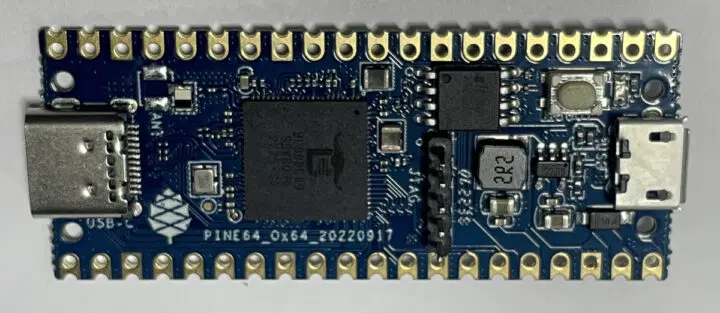A small single-board computer called the Pine64 Ox64 resembles the Raspberry Pi Pico in appearance. The Ox64 includes a dual-core RISC-V CPU, 64MB of inbuilt RAM, and support for up to 128Mb of flash storage in addition to a microSD card for extra storage, whereas the Raspberry Pi's small board is run by an RP2040 microcontroller.
The board also has two 20-pin GPIO headers for expansion, up to 16MB XSPI NOR flash, a MicroSD card slot, and a USB 2.0 OTG connector that supports a 2-lane MIPI CSI camera module. It is only 51 x 21 mm in size, or around the size of a Raspberry Pi Pico W.
CPU Architecture
- T_head C906 480MHz 64-bit RISC-V CPU
- Supports
RISC-V RV64IMAFCV instruction architecture
- Five-stage
single-issue sequentially executed pipeline
- Level-1
instruction and data cache of Harvard architecture, with a size of 32 KB
and a cache line of 64B
- Sv39
memory management unit, realizing the conversion of virtual and real
addresses and memory management
- jTLB
that supports 128 entries
- Supports
AXI 4.0 128-bit master interface
- Supports
core local interrupt (CLINT) and platform-level interrupt controller
(PLIC)
- With
80 external interrupt sources, 3 bits for configuring interrupt priority
- Supports
BHT (8K) and BTB
- Compatible
with RISC-V PMP, 8 configurable areas
- Supports
hardware performance monitor (HPM) units
- T_head E907 320MHz 32-bit RISC-V CPU
- Supports
RISC-V RV32IMAFCP instruction set
- Supports
RISC-V 32-bit/16-bit mixed instruction set
- Supports
RISC-V machine mode and user mode
- Thirty-two
32-bit integer general purpose registers (GPR) and thirty-two
32-bit/64-bit floating-point GPRs
- Integer
(5-stage)/floating-point (7-stage), single-issue, sequentially executed
pipeline
- Supports
AXI 4.0 main device interface and AHB 5.0 peripheral interface
- 32K
instruction cache, two-way set associative structure
- 16K
data cache, two-way set associative structure
- Embedded
64MB PSRAM
Board Features
Network
- 2.4GHz
1T1R WiFi 802.11 b/g/n
- Bluetooth
5.2
- Zigbee
- 10/100Mbps
Ethernet (optional, on expansion board)
Storage
- on-board
16Mb (2MB) or 128Mb (16MB) XSPI NOR flash memory
- microSD
- supports SDHC and SDXC
Expansion Ports
- USB
2.0 OTG port
- 26
GPIO Pins, including SPI, I2C and UART functionality. Possible I2S and
GMII expansion
- Dual
lane MiPi CSI port, located at USB-C port, for camera module
Audio
- mic
(optional, on camera module)
- speaker (optional, on camera module)
There are some additional details including the Ox64 schematic and BL808 datasheet + TRM in the wiki. There have been a number of Arm processors with built-in 64MB to 128MB memory from Allwinner and SigmaStar in recent years, so it's interesting to see Bouffalo Lab doing something similar with the BL808 RISC-V SoC.
Additionally, there is a 26-pin GPIO header that supports a MIPI CSI camera and has GPOIO, SPI, I2C, I2S, and UART. Pine64 says that the system has H.264 and MJPEG encoders, a JPEG decoder, and an audio subsystem and that it aims to provide 10/100 Ethernet, audio, and camera adapter boards in the future.
The board is made exclusively for RTOS and costs $6. It contains 16Mb of flash storage but no microSD card slot. Both versions are anticipated to be ready in November 2022; the $8 variant is intended for Linux development and features 128Mb of storage and a microSD card connector.
















